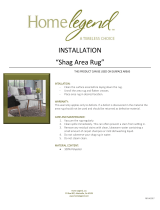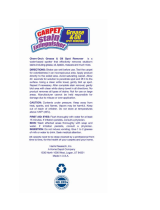Page is loading ...

Carpet Care
& Maintenance
shawoors.com

General Stain Removal Instructions
21
Scrape:
Remove as much of food spills as possible by
scraping gently with a spoon or dull knife.
Absorb:
Absorb wet spills as quickly as possible by blotting
repeatedly with white paper or cloth towels.
Blot:
Always blot; never rub or scrub abrasively, as a
fuzzy area may result. When blotting, work from
the outer edge in toward the center of the spot to
avoid spreading the spill.
Weight:
Remove remaining moisture by placing several
layers of white towels over the spot and weigh
them down with a heavy object that will not
transfer color, such as a plastic jug of water.
Protecting your investment is up to you…
Like other ne furnishings, carpet requires proper care, and you
should reference your residential warranty for specic care require-
ments. There are also a few simple steps you can take to insure the
lasting beauty of your new carpet:
Keep the dirt/soil out. Use walk-off mats at entrances and other
areas to keep outside dirt and moisture from being tracked
onto the carpet. Clean mats frequently. Keep your sidewalks and
entrances free of excessive dirt.
The best way to reduce dirt accumulation and prolong the life
of your carpet is to vacuum, vacuum, vacuum! Most dirt, even
dust, is in the form of hard particles. When left in the carpet,
these gritty, sharp particles abrade the pile as effectively as sand-
paper. How frequently should you vacuum? That depends on the
amount of foot trafc and household soil to which your carpet
is exposed. More use means more frequent vacuuming. Shaw
recommends a vacuum cleaner with a rotating brush or “brush/
beater bar” to agitate the pile and mechanically loosen soil
particles. The exception to this is for shag styled products with
longer yarns which might tend to wrap around a rotating brush.
For these styles we recommend a suction-only vacuum.
Also, be aware that some vacuums have overly
aggressive action which may damage the surface
of your carpet. An inexpensive, less efcient vacuum
can remove surface dirt but will not effectively remove
the hidden particles embedded in the pile.
For your vacuum to conform to the highest industry standards,
make sure that it is certied through the Carpet and Rug
Institute (CRI) Seal of Approval/ Green Label Vacuum Cleaner
Program. Visit www.carpet-rug.org for details and listings.
Prompt attention to spots and spills is essential. Some spilled
materials will stain or discolor carpet if not removed promptly.
Other spills can leave a sticky residue that may result in
increased soiling if not removed.
Prevention
Vacuum Frequently
No carpet is stain proof, although many are
stain resistant, which allows time for removal.
Rinse:
Always follow up with water to remove detergent
residue that may become sticky and cause rapid
resoiling.
Preventive Maintenance
Spots & Spills

Stain Removal Procedures
4
The following chart lists the most common household stains and the
procedure used to remove them. If using more than one procedure,
allow to dry in-between.
Stain Procedure Stain Procedure
Beer B Ink-India, Marking Pen A, M
Berries M Kool-Aid M
Blood M Lemonade M
Butter A Makeup A, B
Candle Wax O, A Mayonnaise B
Candy (sugar) B Mercurochrome M
Catsup M Merthiolate M
Chewing Gum G, A Milk B
Chocolate B Mixed Drinks (liquors) M
Chalk P Mud (dried) P, B
Coffee M Mustard M
Cooking Oil A, B Nail Polish L
Crayon A, B Paint-Latex B
Dirt or Clay P, B Paint-Oil A
Dyes (Blue, Black, etc.) M Pet Food M
Excrement B Shoe Polish A, M
Fruit Juice/Drinks M Soft Drinks M
Furniture Polish A Tar A
Grease-Food A, B Tea M
Grease-Auto A Urine D, M
Glue-White B Vomit B, M
Glue-Hobby A, L Wine B, M
Ice Cream B Unknown A, B
Ink-Ball Point Pen A
Cleaning Solutions
Spot Removal
Shaw’s R2X
®
Stain & Soil Remover is recommended for all
types of spot cleaning and is available from your oor cover-
ing retailer or through www.shawoors.com. It is approved
under the Carpet and Rug Institute’s (CRI) Seal of Approval
certication. Additional cleaning products in the CRI certica-
tion program are listed at www.carpet-rug.org. Do not use
any household cleaners other than those listed in this program,
since many household products contain chemicals that may
permanently damage your carpet.
If one of the recommended products is not readily available you may
use the guidelines below:
Detergent:
Mix 1/4 teaspoon clear hand dish-washing
detergent with 1 cup warm, not hot, water. Use
a clear, non-bleach liquid dishwashing detergent
such as Dawn, Joy, or clear Ivory.
Hydrogen Peroxide/Ammonia:
Mix 1/2 cup hydrogen peroxide (3% solution
available in drug stores) with one teaspoon
undiluted, unscented, clear (non-sudsy)
household ammonia. Use within two hours of
mixing.
Solvent:
Liquid, non-oily, non-caustic type sold for spot
removal from garments. Use products for grease,
oil, and tar removal such as Carbona and Afta.
Do not apply directly to carpet to prevent carpet
damage. (See Procedure A on page 9.)
Vinegar:
1 part white vinegar to 1 part water
Please reference your specic warranty for covered stains. The
stain removal procedures recommended on the following page are
provided to assist in maintaining your carpet and reect the best
information available. Remember, no carpet is stain proof.
WARNING: Certain products found in most homes can
cause irreparable damage to your carpet. Bleaches, tile clean-
ers, mildew removers, oven cleaners, drain openers, pesticides,
and some plant foods can have strong chemicals which discolor
or dissolve carpet bers. Acne medications containing benzoyl
peroxide, a very powerful bleach, are capable of permanently
damaging your carpet and most other fabrics as well.
Ammonia:
One tablespoon to one cup water.
Stain Removal/Cleaning Solutions
3

Stain Removal Procedures
5
Reminder:
With any stain, scrape or blot up excess spill prior to
procedure. Always follow up with water to remove detergent
residue that may become sticky and cause rapid resoiling.
Procedure A:
Apply solvent to dry towel/cloth. Blot, don’t rub. Repeat
application if necessary. Follow with Procedure B.
Procedure B:
Apply detergent solution (see “Cleaning Solutions”) using a
damp towel. Blot, don’t rub. Use a fresh, damp cloth towel to
remove all detergent residue. Blot; nish with pad of paper
towels weighted with a heavy object such as a jug of water or
glass baking dish. If any stain remains, repeat.
Procedure D:
Apply detergent solution (see “Cleaning Solutions”) using a
damp towel. Blot, don’t rub. Use a fresh, damp cloth towel to
remove all detergent residue. If spot remains, apply ammonia/
water solution (see “Cleaning Solutions”) using a damp towel.
Blot, don’t rub. Apply white vinegar (undiluted), only after stain
is removed. Apply water rinse with a damp towel. Blot; nish
with weighted pad of towels.
Procedure G:
Freeze with ice cubes. Shatter with blunt object such as a butter
knife or back of spoon. Remove chips before they melt. If color
remains, follow with solvent (Procedure A).
Procedure L:
Apply solvent remover (non-oily acetone type) to a white,
cotton towel and apply to spill. Do not saturate carpet. Pick up
softened material using a clean, white paper towel, push toward
center of the spot (to avoid spreading material). Repeat above
to soften and carefully remove a layer of the material each time.
Haste may spread the stain and/or damage the carpet. Follow
with Procedure B. If spot remains, apply ammonia solution using
a damp cloth. Blot, don’t rub. Apply white vinegar (undiluted),
only after stain is removed. Apply water rinse with a damp
towel. Blot; nish with weighted pad of towels.
Procedure M:
Apply detergent solution (see “Cleaning Solutions”) to white
towel, leave 3-5 minutes. Blot, don’t rub. If stain is removed,
nish with a water rinse, then blot, then apply a pad of weighted
paper towels. If stain is not removed, continue as follows: Apply
ammonia solution using a damp cloth. Blot, don’t rug. Apply
hydrogen peroxide solution (see “Cleaning Solutions”), let
stand 2-3 hours under a weighted sheet of plastic wrap. Repeat
application of hydrogen peroxide and allow to dry until removal
is complete. Apply white vinegar only after stain is removed.
Apply water with damp towel. Blot and dry with weighted pad
of paper towels.
Stain Removal Procedures
Clean Most Frequently Used Areas More Often
The most frequently used areas of your carpet — entrances,
doorways, trafc lanes, seating areas, etc. will collect dirt much
faster than other areas. By cleaning these areas when they rst
show signs of soiling you can prevent the dirt from spreading to
the rest of the carpeted areas of the house.
Periodic professional cleaning of the overall carpet is highly
recommended. The frequency of overall cleaning may vary
depending on the level and type of trafc and the conditions to
which your carpet is exposed. This may range from as little as 6
months to 24 months between cleanings. Your carpet should be
properly cleaned at least once every 24 months to maintain its
appearance and useful life.
Shaw recommends only hot water extraction, utilizing carpet
cleaning products, equipment, and systems certied through
the Carpet and Rug Institute’s Seal of Approval Program. These
products are listed at www.carpet-rug.org. Warning: Non-
approved cleaning products and topical treatments, applied by
you or by a professional carpet cleaner, may result in damage to
your carpet that will not be covered by your warranty.
Shaw recommends that professional service be performed by an
IICRC certied rm. Locate a professional cleaner through the
Institute of Inspection, Cleaning and Restoration Certication
(IICRC) at 1-800-835-4624 or www.iicrc.org. Cleaning by other
professional services may result in damage that will not be
covered by your warranty.
If you decide to rent a steam cleaning machine and do it
yourself, remember recommended carpet cleaning equipment
and cleaning products should have certication in the CRI Seal
of Approval Programs (www.carpet-rug.org).
Professional Cleaning
Do-it-yourself Systems
Procedure O:
Cover with white cotton towel or brown paper. Lightly apply
warm iron to towel or paper until material is absorbed. Be sure
towel is large enough to cover the stained area. Never touch
the iron directly onto the carpet, as the ber may melt Change
towel or rotate same towel to a clean area and repeat until all
material is absorbed.
Procedure P:
Vacuum as much as possible. Loosen remaining material by
tapping with a scrub brush or toothbrush. Tap with brush, do
not scrub. Vacuum again. If stain remains, use detergent solution
in Procedure B.
6

P.O. Drawer 2128
Dalton, GA 30722-2128
shawoors.com
RC534_03_11_RRD
CARPET
STAIN CENTER
FLOORS
Carrier 9:22 AM
Download our free
Carpet Stain Center app
on your iPhone now!
/



